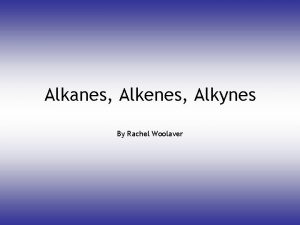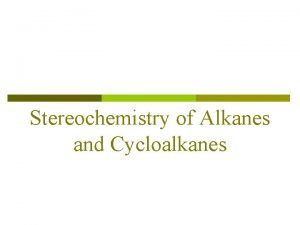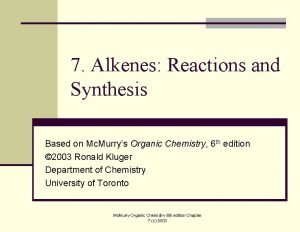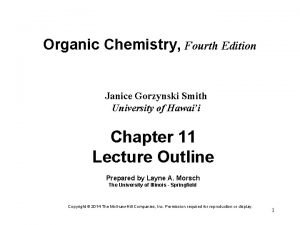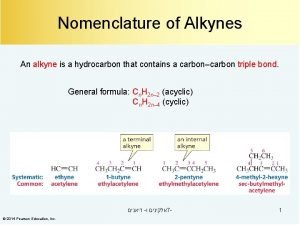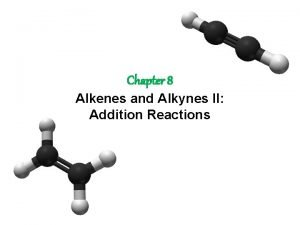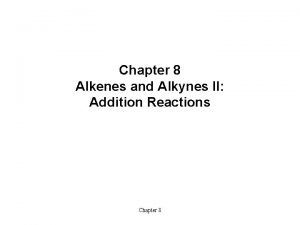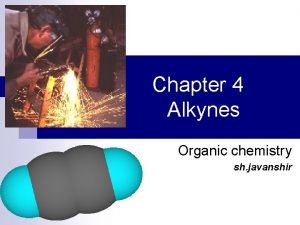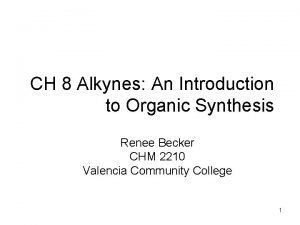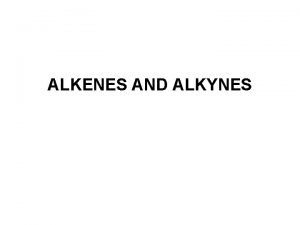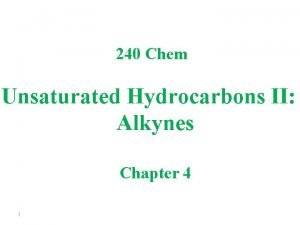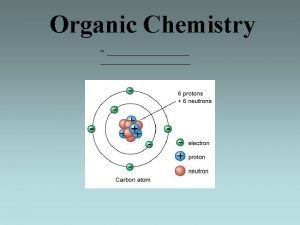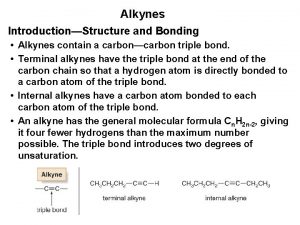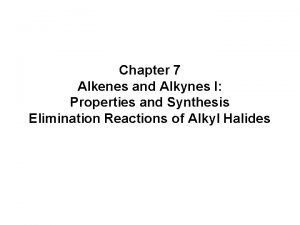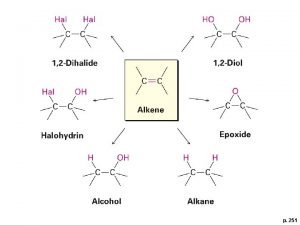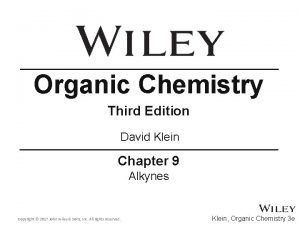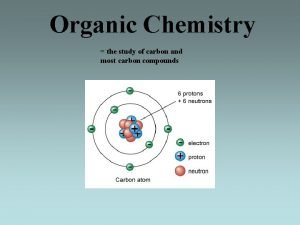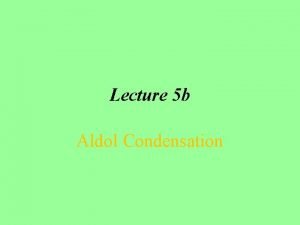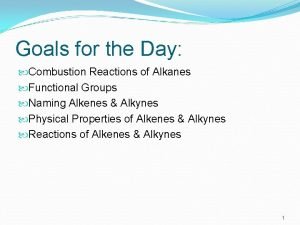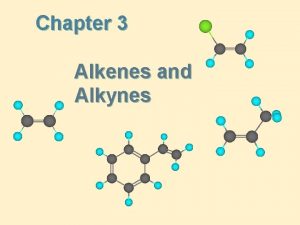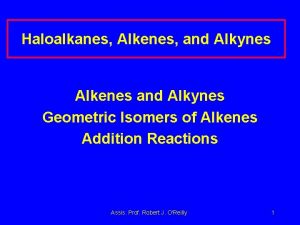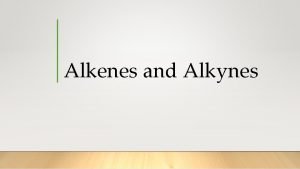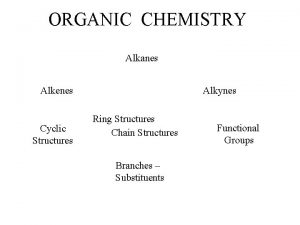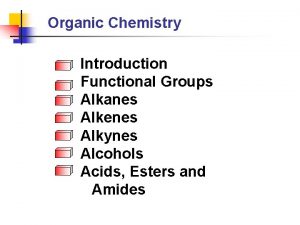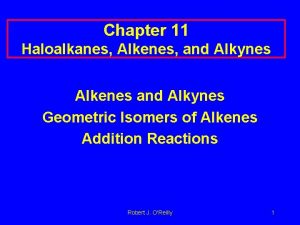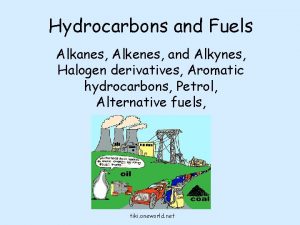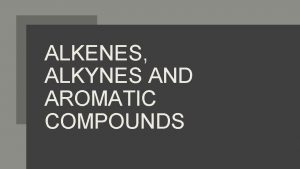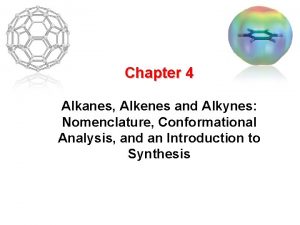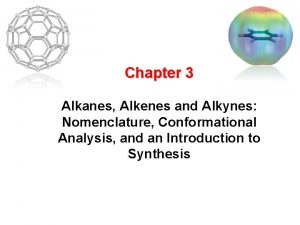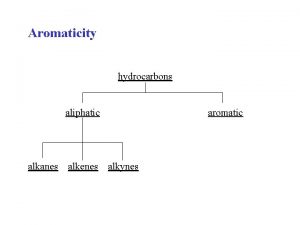ORGANIC TUTORIAL 1 Alkanes Alkenes And Alkynes The


















- Slides: 18

ORGANIC TUTORIAL 1 Alkanes, Alkenes, And Alkynes

The sole purpose of this power point is to serve as a tutorial. If you need help with definitions or specifics as to how to work some of the problems then GET IT INTO TUTORIAL.

MAJOR CONCEPTS I. III. IV. Carbon must have 4 bonds. Oxygen must have 2 bonds. Hydrogen must have 1 bond. Every time a carbon to carbon bond is either made, or saturated, two hydrogens will be involved for every bond involved

HYDROCARBONS Hydrocarbons are organic substances consisting of carbon and hydrogen. They are classified in three main groups: 1. Alkanes H = 2 N + 2 (N=no. carbons) 2. Alkenes H = 2 N (2 H lost so no +2) 3. Alkynes H = 2 N – 2 (2 H lost so now 2) Note that in going from an alkane to an alkene to an alkyne, the formula changes as you are creating carbon to carbon bonds, and therefore, you must lose

PROBLEM 1 What would be the molecular formula if 3 ethanes were combined with pentane and heptane to form one large alkane? Answer next slide.

Since your compound you are making is an alkane, all you need to do is calculate the number of total carbons and then use the formula H = 2 N + 2. Eth = 2 x 3= 6 carbons Pent=5 Hept=7 Your total number of carbons (N) is 18. H=2(18) + 2 so H= 38 C 18 H 38

PROBLEM 2 What would be the molecular formula for the hydrocarbon that is formed when ethane, ane ethene, ene and ethyne are combined?

This problem is similar to the preceding problem except that now you are not making an alkane. The key concept here is that when you combine the molecules, you must lose two hydrogens for every carbon to carbon bond made. Step 1 Write the molecular formulas for the compounds that are to be added. Ethane=C 2 H 6 Ethene=C 2 H 4 Ethyne=C 2 H 2

Ethane=C 2 H 6 Ethene=C 2 H 4 Ethyne=C 2 H 2 Step 2 Add the number of carbons = 6 Step 3 Calculate the number of hydrogens Since you are going to combine three different compounds you will need to make two new carbon to carbon bonds. This means that you will lose a total of 4 hydrogens. Since you have 6 + 4 + 2 = 12 Hydrogens, and you must lose 4 H, your formula and your answer is now C 6 H 8

PROBLEM 3 Would the substance formed in problem 2 be considered saturated or unsaturated? Explain.

A saturated compound is one that contains only single bonds between the carbons. Since you are adding an alkene (one double bond) and an alkyne (one triple bond) the substance would be considered to be unsaturated since it contains double and triple bonds.

PROBLEM 4 How many hydrogens would be needed to saturate a hydrocarbon that is composed of 27 carbons and 6 double bonds and 4 triple bonds?

The concept you are dealing with here is that every time a carbon to carbon bond is made, two hydrogen atoms are involved To convert a double bond into a saturated, or single bond, will involve 2 hydrogens per bond. To convert a triple bond to a saturated or single bond will involve 4 hydrogens per triple bond. 6 double bonds x 2 = 12 hydrogens needed 4 triple bonds x 4 = 16 hydrogens needed So 12 + 16 = 28 hydrogens total needed to saturate the substance.

PROBLEM 5 Give the molecular formulas for the following: A. Pentene that has a carboxyl group added. B. Butyne that is converted into an alcohol. C. Octane that is converted into a ring structure. Is this new structure an alkene?

Pentene is C 5 H 10 The carboxyl group will have the formula R-COOH. Losing 1 Hydrogen from the alkene and adding the COOH gives you C 5 H 9 COOH. The functional group is left intact to let people know that the compound is an organic acid. B. The formula for butyne is C 4 H 6. To convert this to an alcohol you need to lose one hydrogen and replace it with the OH functional group. This gives you C 4 H 5 OH. Like problem A, the functional group is left intact so people will recognize this compound as being an alcohol. A.

PROBLEM 6 What would be the molecular formula of a hydrocarbon if you started with a 50 carbon saturated hydrocarbon, and made it polyunsaturated with 9 triple and 12 double bonds?

Again, the key concept is that any time you make a carbon to carbon bond, you involve 2 Hydrogen atoms Here, going from a single bond to a double bond will cause you to lose 2 H for each bond made. Going from a single to a triple bond means making two additional C-C bonds, so 4 H are involved. Starting with 50 C and H = 2 n +2, so the starting formula is C 50 H 102. Now subtract the H atoms: 9 triple bonds x 4 = 36 H lost 12 double bonds x 2 = 24 H lost Total of 60 H atoms lost so the new formula is C 50 H 42.

C. The molecular formula for octane is C 8 H 18. To convert the straight chained hydrocarbon into a ring structure involves combining the end carbons to make one carbon to carbon bond. This means that two hydrogen atoms will be lost in the making of the bond. The new formula is now C 8 H 16. Note: the new substance is not an alkene, even though it has the correct molecular formula. The reason being is that you do not have a double bond.
 Alkanes alkenes alkynes
Alkanes alkenes alkynes Gauche conformation
Gauche conformation Diol formation from alkene
Diol formation from alkene Halogenation of alkynes
Halogenation of alkynes Lindlar pd
Lindlar pd 2-methylpropene + hbr
2-methylpropene + hbr Addition of hydrogen halides to alkynes
Addition of hydrogen halides to alkynes Mercury catalyzed hydration of alkynes
Mercury catalyzed hydration of alkynes Mercury catalyzed hydration of alkynes
Mercury catalyzed hydration of alkynes Alkene general formula
Alkene general formula Ozonolysis of alkynes
Ozonolysis of alkynes Alkynes structural formula
Alkynes structural formula Alkynes
Alkynes Alkynes
Alkynes Dihydroxylation
Dihydroxylation Alkane to alkyne
Alkane to alkyne First 10 members of alkynes
First 10 members of alkynes Filter plates for aqueous filtration
Filter plates for aqueous filtration Combustion reaction of alkanes
Combustion reaction of alkanes
